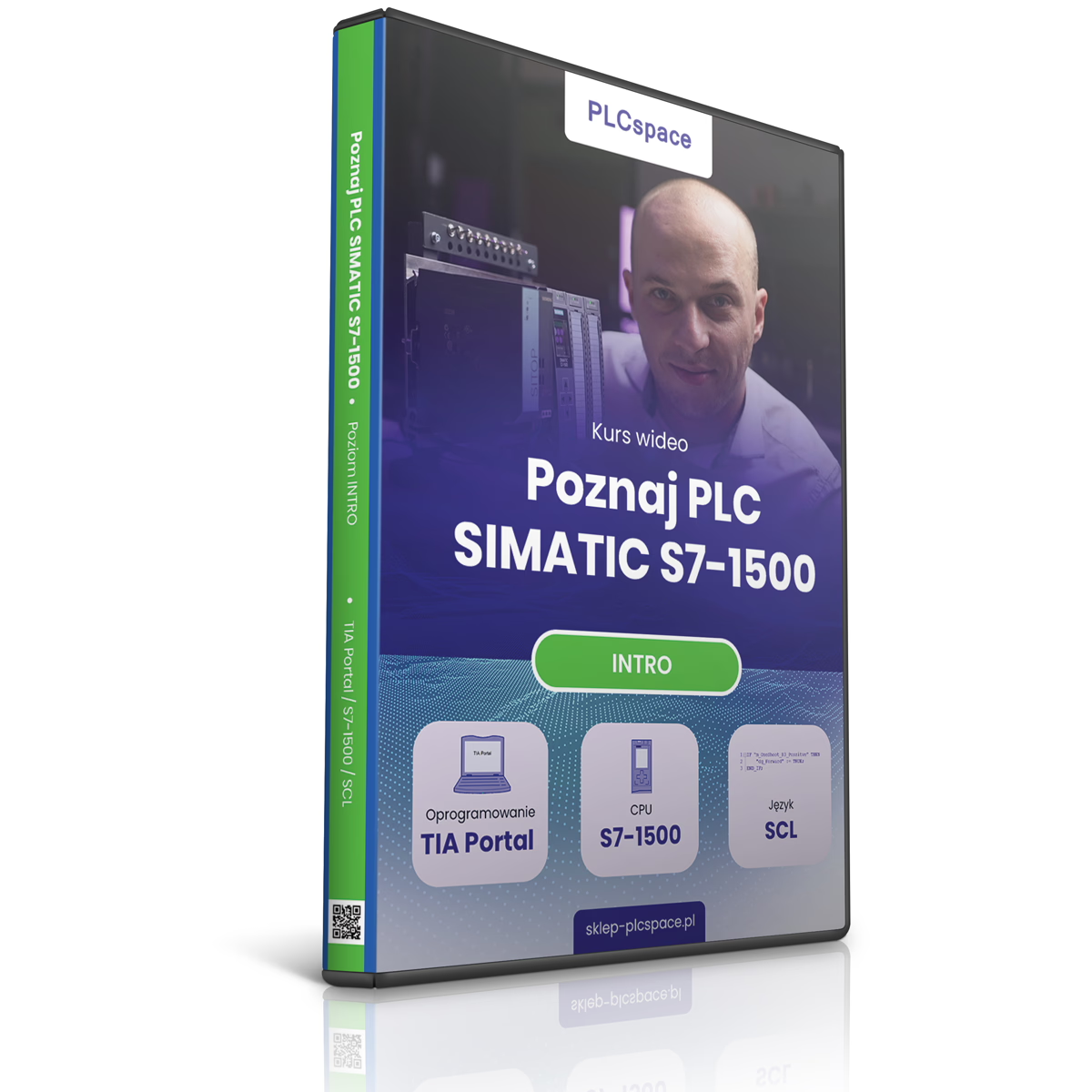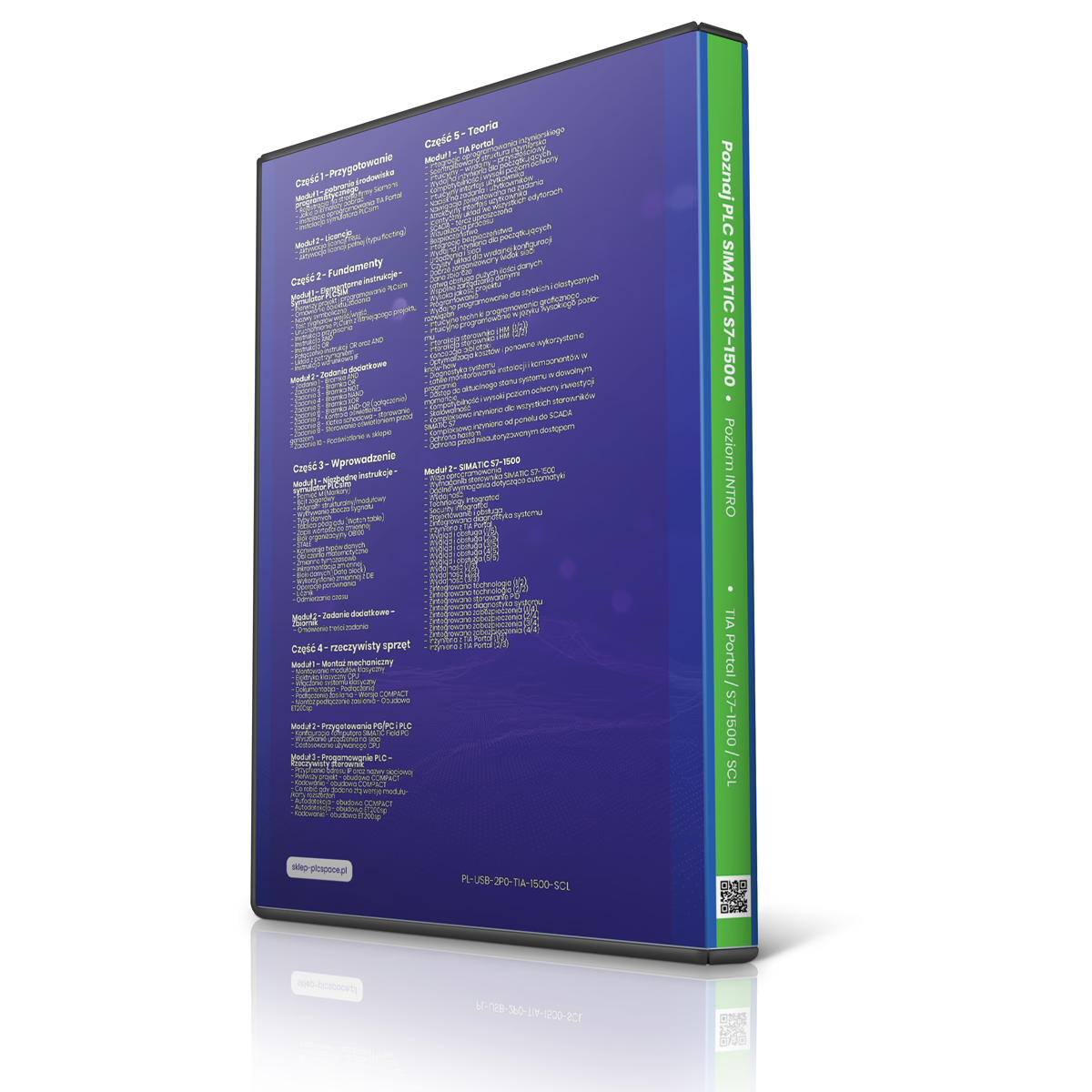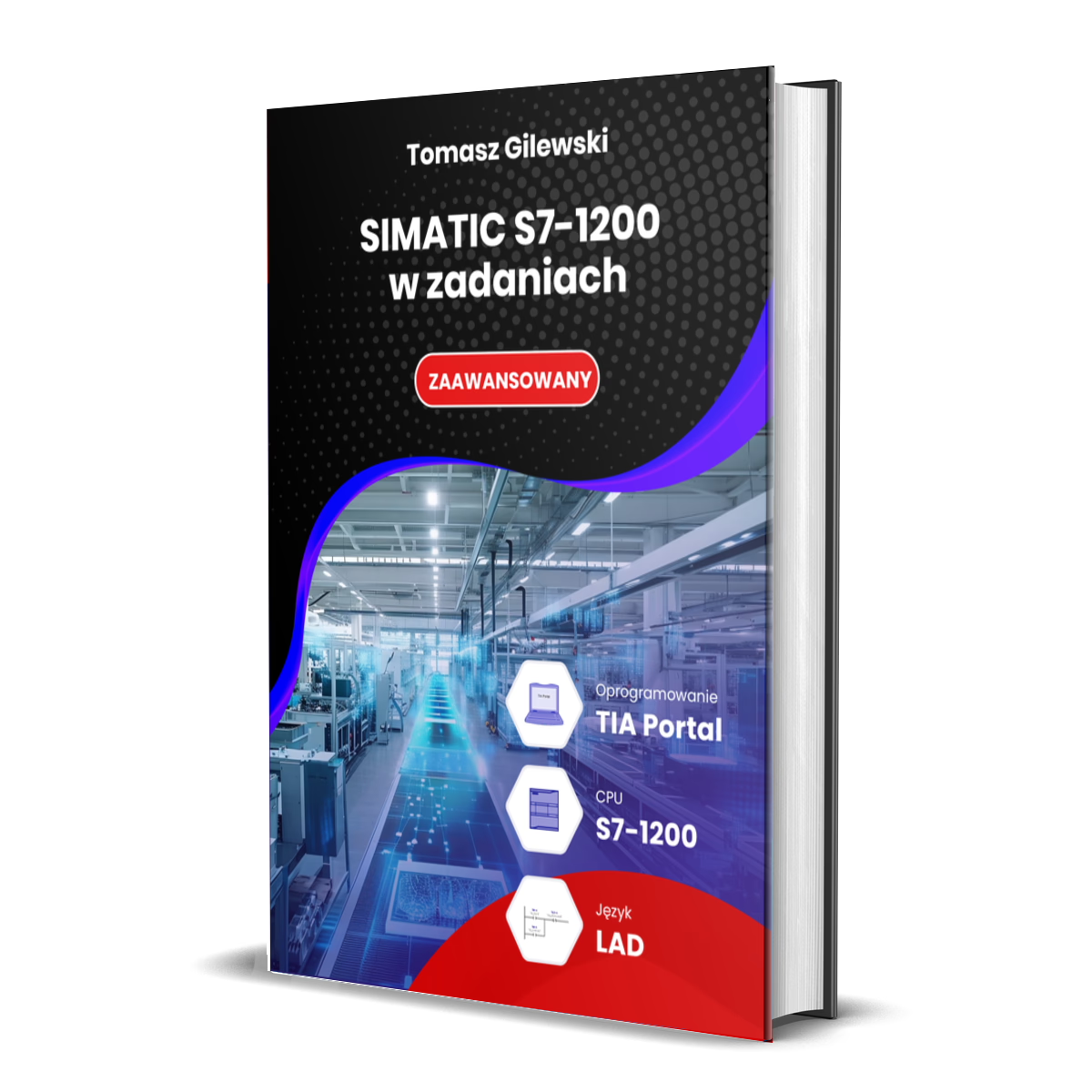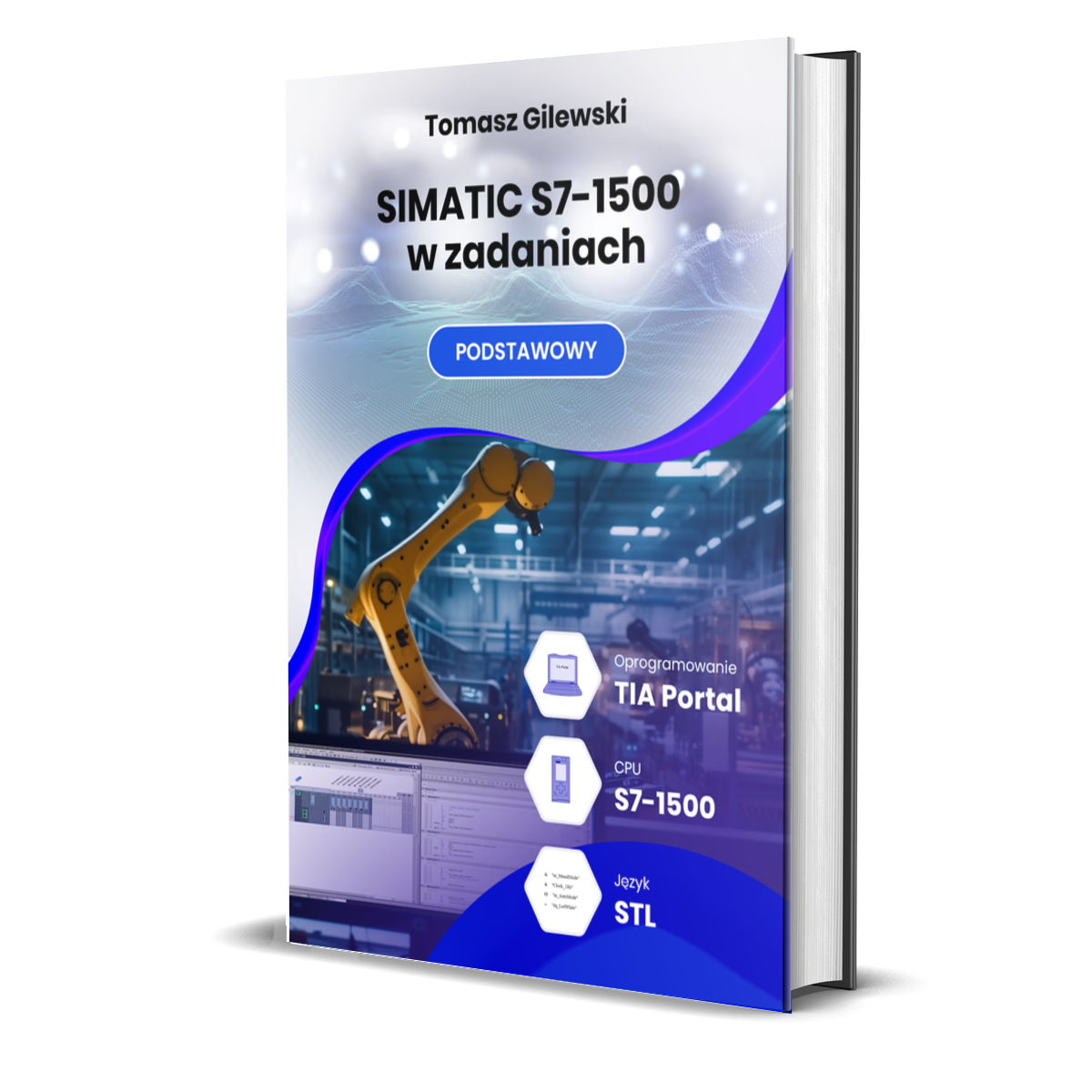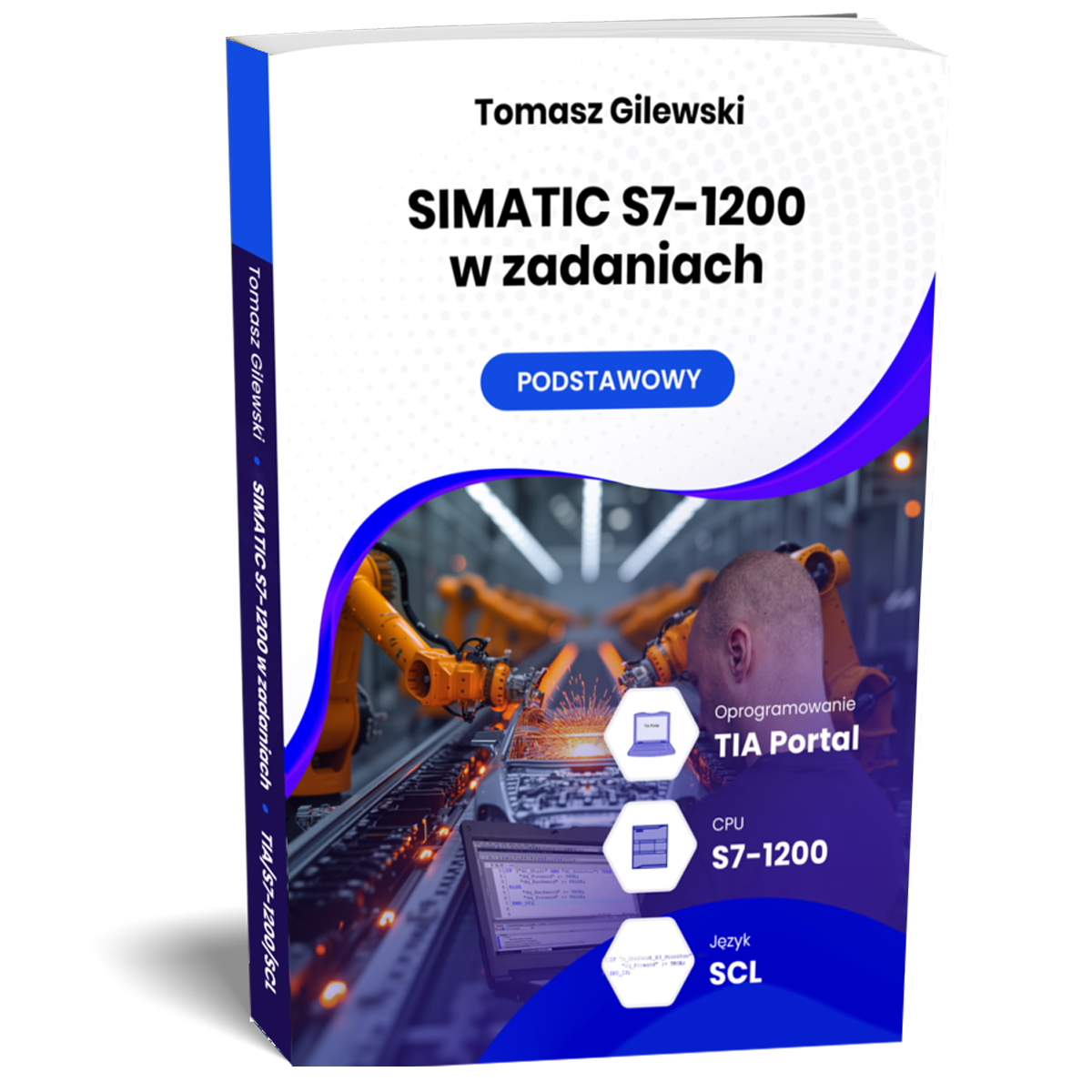Get to know the SIMATIC S7-1500 PLC - INTRO
- Level:
The development environment used in the course
- Software:
Core unit family used in the course
- CPU:
A set of rules that are used to develop programme code
- Language:
Frequency converter (inverter) family used in the course
- Drive
79.00 zł – 99.00 zł
What do you get when you enrol on a PLC programming course?
- We present more than 8 hours of material in HD quality, with no time limit. The materials enable you to consolidate your knowledge and solve tasks on your own. You follow the tutor's actions closely and have the option of repeating them precisely.
- During the training you will perform a variety of tasks in the TIA Portal environment, discovering its potential. You will acquire a sound knowledge of Siemens PLC modules. By creating projects in TIA Portal, you will explore the complex functionality of this platform and acquire comprehensive knowledge of SIMATIC S7-1500 controllers.
- Our INTRO course has been carefully created, to introduce you to the basics of programming industrial controllers.
- Ensuring solid foundations and familiarise you with the necessary skills required to work with a PLC.
- You will have access to a wealth of educational material, experts and practical exercises to develop your S7-1500 controller programming skills.
- Materials enable the consolidation of knowledge and solving tasks independently.
- You carefully observe the actions of the leader and you have the option of repeating them precisely.
As part of the training you will receive:
Siemens SIMATIC S7-1500 PLC programming course, INTRO level - TIA Portal software
Are you interested in PLC programming? Have you never had experience with industrial controllers? Great! This INTRO course is specifically tailored to your needs. You will gain knowledge of the most popular Siemens controller - the SIMATIC S7-1500.
What is the Siemens SIMATIC S7-1500 PLC programming course in SCL about?
Our introductory course on Siemens SIMATIC S7-1500 PLC programming in SCL is a comprehensive coverage of automation and PLC programming. We will make use of the commonly used SIMATIC S7-1500 family controller and the TIA Portal platform. You will gain information on how to properly connect electrical equipment and install software. You will be introduced to the basics of PLC programming, where you will practically use key programming instructions. This is an introductory course that will provide you with the necessary minimum knowledge in the area of industrial automation. Join now and discover the fascinating world of PLC S7-1500 programming in SCL language.
Knowledge test:
Is this course for you? Take this test MULTIPLE choice to check it out.
Key information about the course
As you complete practical tasks, you will see that programming is not as complicated as you might think.
By attending the course, you will immerse yourself in the interesting world of the industry and gain essential industry knowledge.
You will broaden your competences by drawing on the experience of other programmers.
You will find a tool that will enable you to set up the PLC, create a programme and program the device. At the end, you will see the results of your work.
You get a comprehensive set of information, which will save you time and avoid basic mistakes in the course of your duties.
Why choose our industrial automation and PLC programming course in the SCL language?
Join us for the INTRO PLC S7-1500 programming course in the SCL language, which stands out for its innovative and proven method, developed on the basis of extensive experience with participants. This course provides a unique opportunity to acquire the practical knowledge necessary to successfully program industrial controllers.
During the course you will learn a number of key skills as we introduce you to the fascinating world of PLC programming. This will help you understand that it's not as complicated as you might think. The lessons are carefully structured, focusing on practical aspects so that you can fully understand and effectively apply the knowledge you have gained to real-world applications.
You will learn to program in the SCL language, which is a powerful tool for creating advanced controller programs. You will also become familiar with the TIA Portal development environment, which will enable you to use advanced configuration and programming features.
During the course, you will master, among other things, the configuration of the S7-1500 PLC modules and the creation of simple programs on the SIMATIC S7-1500 family PLC.
No previous programming experience is required. Our course has been specifically designed for both those who are new to PLC and those who want to expand their knowledge and skills.
Join our community of learners and start a fascinating journey through the world of PLC S7-1500 programming in SCL language. Now is your chance to start your adventure in industrial automation and gain the necessary knowledge to become an expert in this field. Sign up for the INTRO course today!
Example lesson from the course
What is the training in SCL programming of the SIMATIC S7-1500 controller in the TIA Portal environment?
The most important news is that you have the option of doing the exercises yourself on your computer.
The S7-1500 in SCL course offers a range of practical PLC programming tasks. Participants use a tank object, which is simulated in the programme, to practically apply PLC programming.
During the course, participants perform programming exercises in the SCL language and understand the applications of PLCs in the context of industrial processes.
Initial tasks include creating the project in TIA Portal, testing the signals and dividing the application into modules. The focus then shifts to controlling the valve and traffic lights, and running the valve on an edge.
The main topics of the course include creating global constants in PLC tags, using temporary and local variables, calculating tank volumes, creating variables in a data block and implementing manual mode functions.
The course introduces participants to the basic operations of SCL programming and teaches the practical application of these skills in industrial process control.
Participants also learn fundamental programming instructions and techniques such as conditional instructions, mathematical instructions, variable handling, time handling and the use of various function blocks. These skills enable the development of tank applications, implementing a variety of functionalities related to the control, monitoring and management of industrial processes.
The table of contents has been carefully designed to form a logical thematic sequence.
-
Module 1 - downloading the development environment
- Lesson 1 - Registration on the Siemens website
- Lesson 2 - Which files to download
- Lesson 3 - Installation of the TIA Portal software
- Lesson 4 - Installing the PLCsim simulator
-
Module 2 - Licence
- Lesson 1 - Activating a TRIAL licence
- Lesson 2 - Activating a full (floating) licence
-
Module 1 - Elementary instruction - PLCsim simulator
- Lesson 1 - First project and PLCsim programming
- Lesson 2 - Overview of the object/task
- Lesson 3 - Symbolic names
- Lesson 4 - Test of input/output signals
- Lesson 5 - Starting PLCsim from an existing project
- Lesson 6 - Assignment instructions
- Lesson 7 - AND instruction
- Lesson 8 - OR instruction
- Lesson 9 - Combination of OR and AND statements
- Lesson 10 - Layout with holding
- Lesson 11 - Conditional instruction IF
-
Module 2 - Additional tasks
- Lesson 1 - Task 1 - AND gate
- Lesson 2 - Task 2 - OR gate
- Lesson 3 - Task 3 - NOT gate
- Lesson 4 - Task 4 - NAND gate
- Lesson 5 - Task 5 - NOR gate
- Lesson 6 - Task 6 - XOR gate
- Lesson 7 - Task 7 - AND-OR gate (connection)
- Lesson 8 - Task 8 - Lighting control
- Lesson 9 - Task 9 - Staircase - control
- Lesson 10 - Task 10 - Controlling the lighting in front of the garage
- Lesson 11 - Task 11 - Highlighting in the shop
-
Module 1 - Essential instructions - PLCsim simulator
- Lesson 1 - Memory M (Markers)
- Lesson 2 - Clock byte
- Lesson 3 - Structured/modular programme
- Lesson 4 - Signal edge detection
- Lesson 5 - Data types
- Lesson 6 - Watch table
- Lesson 7 - Writing values to a variable
- Lesson 8 - Organisational block OB100
- Lesson 9 - FIXED
- Lesson 10 - Converting data types
- Lesson 11 - Mathematical calculations
- Lesson 12 - Temporary variables
- Lesson 13 - Incrementing a variable
- Lesson 14 - Data blocks
- Lesson 15 - Using a variable from the DB
- Lesson 16 - Comparison operations
- Lesson 17 - Counter
- Lesson 18 - Timing
-
Module 2 - Additional task - Tank
- Lesson 1 - Discussion of task content
-
Module 1 - Mechanical assembly
- Lesson 1 - Assembling the classic modules
- Lesson 2 - Electricity classic CPU
- Lesson 3 - Switching on the classic system
- Lesson 4 - Documentation - Connection
- Lesson 5 - Connecting the power supply - COMPACT version
- Lesson 6 - Power connection assembly - ET200sp enclosure
-
Module 2 - PG/PC and PLC preparations
- Lesson 1 - Configuring the SIMATIC Field PG computer
- Lesson 2 - Searching for a device on the network
- Lesson 3 - Adapting the CPU in use
-
Module 3 - PLC Progamming - Actual
- Lesson 1 - Assigning an IP address and a network name
- Lesson 2 - First project - COMPACT housing
- Lesson 3 - Coding - COMPACT housing
- Lesson 4 - What to do when the wrong version of a module/extension card has been added
- Lesson 5 - Auto-detection - COMPACT housing
- Lesson 6 - Auto-detection - ET200sp enclosure
- Lesson 7 - Coding - ET200sp enclosure
-
Module 1 - TIA Portal
- Lesson 1 - Integration of engineering software
- Lesson 2 - Centralised engineering structure
- Lesson 3 - Intuitive - efficient - future-oriented
- Lesson 4 - Efficient engineering for beginners
- Lesson 5 - Compatibility and high level of protection
- Lesson 6 - Intuitive user interface
- Lesson 7 - Emphasis on tasks and users
- Lesson 8 - Task-oriented navigation
- Lesson 9 - Attractive user interface
- Lesson 10 - Identical layout in all editors
- Lesson 11 - SCADA - now simplified
- Lesson 12 - Visualising the process
- Lesson 13 - Safety
- Lesson 14 - Integrating safety
- Lesson 15 - Efficient engineering for beginners
- Lesson 16 - Devices and networks
- Lesson 17 - A "clean" layout for an efficient configuration
- Lesson 18 - A well-organised view of the web
- Lesson 19 - Aggregated data
- Lesson 20 - Easy handling of big data
- Lesson 21 - Collaborative data management
- Lesson 22 - High quality design
- Lesson 23 - Programming
- Lesson 24 - Efficient programming for fast and flexible solutions
- Lesson 25 - Intuitive graphic programming techniques
- Lesson 26 - Intuitive programming in a high-level language
- Lesson 27 - Controller and HMI interaction (1/2))
- Lesson 28 - Controller and HMI interaction (2/2)
- Lesson 29 - Library concept
- Lesson 30 - Cost optimisation and re-use of know-how
- Lesson 31 - System diagnostics
- Lesson 32 - Easy monitoring of installations and components in the program
- Lesson 33 - Accessing the current status of the system at any time
- Lesson 34 - Compatibility and high level of investment protection
- Lesson 35 - Scalability
- Lesson 36 - Comprehensive engineering for all SIMATIC S7 controllers
- Lesson 37 - Complex engineering from panel to SCADA
- Lesson 38 - Password protection
- Lesson 39 - Protection against unauthorised access
-
Module 2 - S7-1500
- Lesson 1 - Software vision
- Lesson 1 - Requirements of the SIMATIC S7-1500 controller
- Lesson 2 - General automation requirements
- Lesson 3 - Performance
- Lesson 4 - Technology Integrated
- Lesson 5 - Security Integrated
- Lesson 6 - Design and operation
- Lesson 7 - Integrated system diagnostics
- Lesson 8 - Engineering with TIA Portal
- Lesson 9 - Appearance and operation (1/5)
- Lesson 10 - Appearance and operation (2/5)
- Lesson 11 - Appearance and operation (3/5)
- Lesson 12 - Appearance and operation (4/5)
- Lesson 13 - Appearance and operation (5/5)
- Lesson 14 - Performance (1/3)
- Lesson 15 - Performance (2/3)
- Lesson 16 - Performance (3/3)
- Lesson 17 - Integrated technology (1/2)
- Lesson 18 - Integrated technology (2/2)
- Lesson 19 - Integrated PID control
- Lesson 20 - Integrated system diagnostics
- Lesson 21 - Integrated security (1/4)
- Lesson 22 - Integrated security (2/4)
- Lesson 23 - Integrated security (3/4)
- Lesson 24 - Integrated security (4/4)
- Lesson 25 - Engineering with TIA Portal (1/3)
- Lesson 26 - Engineering with TIA Portal (2/3)
- Lesson 27 - Engineering with TIA Portal (3/3)
- Lesson 28 - Integrated security
- Lesson 29 - Summary
Software and hardware used
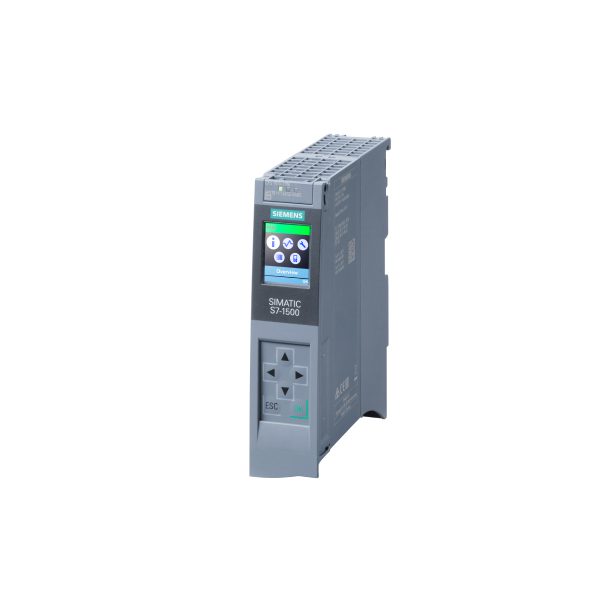
CPU S7-1500
They are available in the classic and et200sp housing. The SIMATIC S7-1500 is a modular automation system with medium and higher performance. Different controller versions allow you to match the corresponding application. Depending on requirements, the programmable controller can be expanded with input/output modules for digital and analogue signals, as well as technology and communication modules.
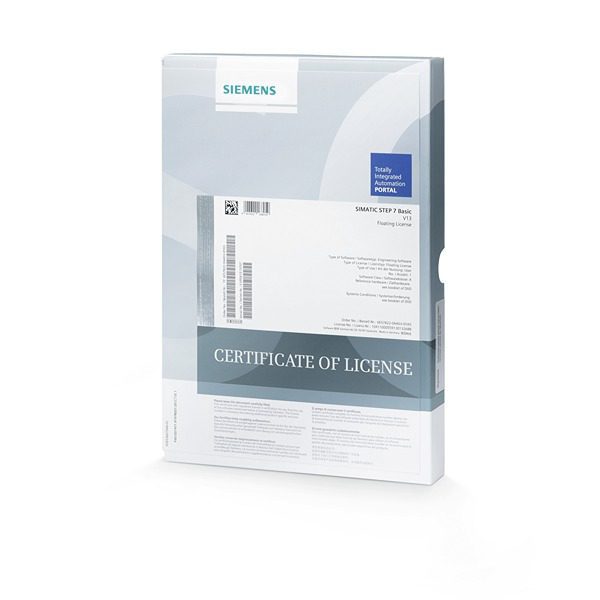
TIA Portal software
Totally integrated automation is a development environment that combines PLC (programming), HMI(visualisation) and startdrive(drive technology).
What will you be able to do after completing the course?
Regardless of your chosen career path, completing this course will contribute to your professional goals and enhance your competence in PLC programming. Learning about the programming topics presented is the first step to taking up a position:
Bear in mind that merely acquiring theoretical knowledge is only the beginning. In the INTRO course, we focus mainly on the practical application of information. This will enable you to master practical skills more effectively, just by taking the time to process the material and doing the exercises. Through practice, you will consolidate the knowledge you have acquired and gain confidence in programming PLCs from the SIMATIC S7-1500 family in the SCL language. Our goal is for you not only to understand the theory, but also to be able to apply it effectively in practice. We encourage you to actively participate and systematically complete the exercises, which will enable you to achieve better results and appear as a confident and competent PLC programmer.
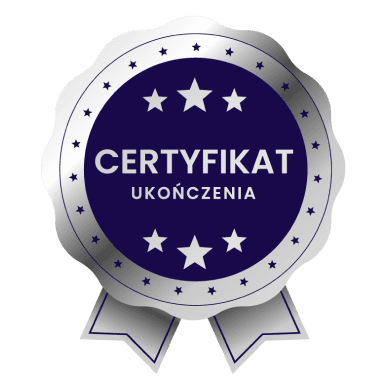

Guarantee
and certificate
If, after 14 days of purchase, you find that it is not for you, I will refund 100% of the course price. Upon completion of the course, you will receive a certificate in two languages - Polish and English.

Frequently asked questions
-
Do I need to have some basic knowledge of programming and PLC?
No. It's all in the course. We start from scratch.
-
Is it worth starting to learn with a Siemens PLC?
Yes. Siemens PLCs are in about 95% factories in Poland. The situation is similar in Europe. It is useful to have at least a general idea of this hardware and programming environment.
-
How long will I have access to the course?
Indefinitely.
-
Does enrolling in a course commit you to anything?
No. It is voluntary and at 100% for 0 PLN. It is possible to cancel at any time.
-
Is it worth learning PLC programming?
Everything nowadays lives up to automation to increase productivity and repeatability. Companies want to produce for 24 hours. You need machines and process lines to do all this. Someone has to program this, so you need PLC programmers. If you want to become a PLC programmer, this course would be a good way to start.
-
Why have I created a free course on PLC programming?
I think that anyone in the automation/electrical/mechanical field as well as pupils and students in these technical fields should familiarise themselves with this subject. Then you will be able to say whether this is for me. Whether I like it.
-
Who is this course for?
For people WITHOUT programming experience. For people who have no experience with Siemens PLCs. For all those who want to go step by step through the steps involved in the first commissioning of what is now the most popular PLC of the SIMATIC S7-1200 family.
Buy as a set and save
Select at least 2 courses from the list and the first free book item (three selections in total) and an automatic discount of 25% will be calculated in your basket.
If you want to find out more about a particular course, click on its name and the page will take you to its offerings.
Buy as a set and save
Companies that have benefited from our courses




































Feedback from students
 Stanislaw
Stanislaw
What sets this course apart is the opportunity to acquire practical, concrete knowledge. Everything is clearly explained. Definitely recommended!
 Marcel
Marcel
After going through the course, I know what the components of the programming environment are and what to do step by step. Now I feel confident and know what I am doing
 Leon
Leon
Course delivered in a very accessible way. Contains a lot of interesting and useful information.
 Michael
Michael
I can honestly recommend the course. It is solid and factual knowledge. I will definitely be buying more.
 Victor
Victor
Thanks to the course, I have decided to go further in this direction. The goal is to look for a more challenging and better job
 Peter
Peter
The course prepared by Mr Tomasz is distinguished by its high level of content and meticulously prepared lessons. They are planned in a clear and sensible manner, making it easier to assimilate knowledge and return to the material if necessary. An additional advantage is the possibility of a free consultation.
 Nikodem
Nikodem
Definitely recommended! The facts themselves, no unnecessary dwelling on issues.
 Ignatius
Ignatius
This is my first course, certainly not my last. I am impressed with the substantive quality of the knowledge.
 Tymon
Tymon
Everything clearly explained, you can really learn a lot. Lots of practical information and examples to help you remember everything. In my opinion, it is worth using this form of learning because you can learn anytime and anywhere. It is practical and convenient.
You may also be interested in:
- Level:
The development environment used in the course
- Software:
Core unit family used in the course
- CPU:
A set of rules that are used to develop programme code
- Language:
Frequency converter (inverter) family used in the course
- Drive
39.00 zł
- Level:
The development environment used in the course
- Software:
Core unit family used in the course
- CPU:
A set of rules that are used to develop programme code
- Language:
Frequency converter (inverter) family used in the course
- Drive
39.00 zł
- Level:
The development environment used in the course
- Software:
Core unit family used in the course
- CPU:
A set of rules that are used to develop programme code
- Language:
Frequency converter (inverter) family used in the course
- Drive
1.824.00 zł
- Level:
The development environment used in the course
- Software:
Core unit family used in the course
- CPU:
A set of rules that are used to develop programme code
- Language:
Frequency converter (inverter) family used in the course
- Drive
39.00 zł
